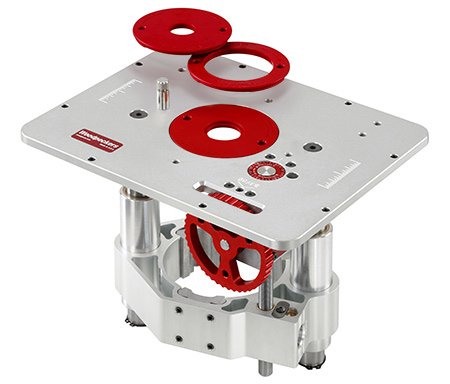For what it's worth, your DeWalt 625 will not work with most router lifts on the market. Most lifts are designed to work with a removable motor from a fixed-base router, and you'll need to look into a different solution such as one of those that I suggested in my answer to other router question that you referenced. The DeWalt 625 is a plunge router with an integral, non-removable motor. But for the sake of argument and the benefit of others, let's pretend you also have another router which is compatible with most lifts.
Strictly speaking, the only feature most people need from a router lift is the ability to easily raise and lower the router by very small increments.
Let's address a few of your questions about specific features:
Do I need a "quick change" ring to facilitate bit changes?
If you're referring to the red rings in the illustration below, these are important not just for changing bits, but to use different-diameter bits. You want to give your workpiece as much support as possible as it passes by the bit, so you should use the smallest insert ring that gives your bit adequate clearance through its entire height range.
Many router lifts include a router table insert plate (the gray rectangular flat piece) with insert rings, but some do not. You can also buy router plates with or without the rings, or you can make your own. For this reason, I consider this part not so much a part of the router lift, but an accessory that you can add separately. That said, the mounting plates included with some of the more expensive router lifts do have additional features such as precision markings or easier adjustments.

(Source)
Do I need to be able to lock the lift to a particular height?
I could be wrong but I would suspect that this feature is included on most commercially-available lifts. This is good to have in order to guarantee that your router won't drift up or down with vibration and use, but it depends on what's more important to you and whether your specific lift has a tendency to travel out of adjustment with use. Is it more important to be able to change settings quickly, or to keep the same setting for a long time? Whether or not you use the height lock may also depend on the job. If you're producing mating parts with tight tolerances, you may want to lock the router height. But if you're just cutting an ogee or roundover as a cosmetic detail, and your lift more or less doesn't go out of adjustment on its own, you're probably fine.
I just use a Bosch fixed router base as my lift and haven't had a problem. I would suspect most screw-driven lifts hold their settings pretty well, but if you find a router lift that has a lot of slop in its adjustment mechanism, you'll probably want to lock the height once you've adjusted it.
Does a flex-shaft controller (that I can attach to the side of the router) work better/worse than a screw controller (that means I have another hole through my insert plate?
As with many tool features, this is largely a convenience since you can have a "remote" adjustment crank or knob on the side or your router table. You don't have to potentially move your workpiece out of the way to make an adjustment.
Others?
- A touchscreen- or foot-controlled powered router lift/automatic height adjustment would be great in many situations, for example, when making many successively deeper passes (which is pretty much every time you use your router, right?). But if it causes you to speed up too much, you might stop thinking about safety and you could potentially raise the bit directly into your hand (for example, if cutting out a circle and raising the bit a little on each pass).
- Quick bit changes. Some router lifts have ways to speed up bit changes and/or make them less awkward. If you're buying a router lift instead of building one, you might use this feature as a tiebreaker when deciding between two lifts, but there are other accessories you can buy to speed up/simplify bit changes, which are not tied to a specific router lift. I certainly wouldn't spend any extra money on the lift for this feature, but here are a couple ways lifts implement quick bit changes:
- Easily-removable base plate: many router tables are designed so you can quickly and easily lift the insert plate and router out of the table to more easily change bits. As I mentioned earlier, some router lifts include the insert plate.
- Maximum height: this may be what you were really getting at with your question about the quick change rings, but some router lifts can raise the collet and shaft above the table, so you don't have to pull the entire weight of the router plate, lift, and router out of the table. This can be handy, but you could also add a collet extension to achieve the same effect. Or you could add a quick-change chuck for even faster bit changes.
